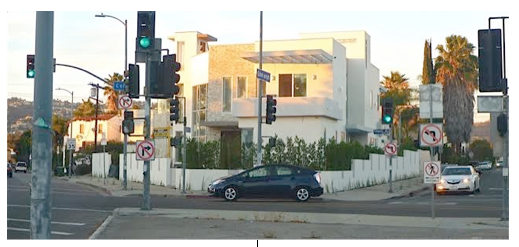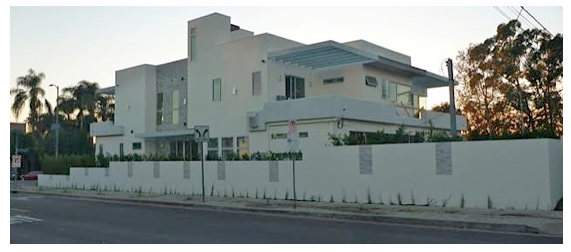PLATKIN ON PLANNING--If you live in or have barreled through the Fairfax area during the past two years, you have undoubtedly seen an aircraft carrier masquerading as a house at the confusing intersection of Crescent Heights, Colgate, and Edinburgh. As you can see from the attached photos, this behemoth faces three streets, with no more screening than a basic fence and a few sprigs recently stuck in its gravel perimeter. (Photo top: New McMansion at Crescent Heights, Colgate and Edinburgh.)
Most people driving by this site assume this structure must be an apartment house or a commercial building, but it is a single-family house. Furthermore, it is fully legal according to the Baseline Mansionization Ordinance (BMO. This McMansion, in particular, is powerful visual evidence of the BMO’s lethal loopholes, variously inserted by City Planning, the City Planning Commission, and the City Council. Combined with lax enforcement by Building and Safety, the BMO has been a colossal failure, especially when stacked up against its intended purposes. Indeed, it is the height of hypocrisy that the same City Planning Commission that gutted the Baseline Mansionization Ordinance also adopted its Do Real Planning policy statement at nearly the same time, with its uncompromising opposition to mansionization.
NEUTRALIZE mansionization: Neighborhoods zoned single-family deserve our protection.The most pervasive threat they face is the replacement of existing homes with residences whose bulk and mass is significantly larger than the street’s current character — sacrificing greenery, breathing room, light, and air. Let’s be the champions of a citywide solution to prevent out-of-scale residences.
Needless to say, from the standpoint of the mansionizers and their City Hall helpers, the BMO has been a colossal success. It is has not even offered token barriers to their demolition of thousands of smaller, older, affordable homes, quickly followed by their replacement with pricey garrisons, such as the McMansion above. In fact, the only true barrier the mansionizers faced was finding enough buyers who had more money than taste. Considering how long some of their spec houses have stayed on the market, this, not municipal laws, has been their biggest problem to date.
Pushback by local communities: For about a decade, though, many neighborhoods, beginning with Beverly Grove, where I live, have tried to stop this assault of community character, privacy, and home values.
So far, most of these efforts to stop mansionization have fizzled out. About 30 small areas are protected by Historical Preservation Overlay Ordinances, most of which were adopted before the mansionization craze moved into high gear. An additional three neighborhoods have Residential Floor Area Districts (RFA), soon to be joined by a fourth, Old Granada Hills. Another 23 neighborhoods have short-term protection through Interim Control Ordinances. Because of the wide range of provisions, though, even an RFA or an ICO is no guarantee that all McMansions will be stopped.
Added together, all of these various overlay zones still leave most Los Angeles communities with single-family homes open to rampant mansionization. The colossus at Crescent Heights-Colgate-Edinburgh could still be built in any of these communities, and at this point there is no combination of laws and enforcement that could stop it.

Same McMansion, looking northwest from intersection of the three streets.
There may finally be a credible answer to mansionization, however, because in May 2013, the City Council adopted a motion introduced by Councilmember Koretz directing the Department of City Planning to finally close the loopholes that have rendered the Baseline Mansionization Ordinance a worthless statute. Although the Department of City Planning dawdled for nearly two years in implementing the Council Motion, they have finally released draft amendments to the Baseline and Hillside Mansionization Ordinances.
This draft is now ready for public review, and City Planning will hold four workshops through December to present it to the public and obtain feedback in both oral and written testimony. The public meetings take place on December 3, 4, 15, and 16. The deadline for written comments is January 11, 2016.
So how good is City Planning’s draft? The answer is that the amendments are much better than the existing Baseline Mansionization Ordinance and the parallel Hillside Mansionization Ordinance. But, unfortunately, the draft ignores important instructions from the City Council.
First, it continues to exempt semi-enclosed balconies, breezeways, and decks from square footage calculations. These habitable areas can significantly increase the bulk of a house, and this is why the Baseline Mansionization Ordinance restricts them to 250 square feet. In contrast, the draft amendments make this situation much worse, not better. They have no cap on the size of the semi-enclosed areas. A mansionizer could legally adorn a house with several thousand square feet of lattice-covered decks, balconies, and breezeways. This exemption was totally removed in the Beverly Grove Residential Floor Area District, and it should be totally removed from the amended Baseline Mansionization Ordinance. This is what the City Council directed the City Planning Department to undertake, and Planning should stick to its marching orders.
Second, the other feature that defies the Council Motion is the retention of a 20 percent size bonus when the second story of a house is 60 percent or less than the first floor. This loophole could add nearly 600 square feet to the size of a house on a small, 6000 square foot R-1 lot. Since the Council Motion was clear that any bonus that contributes to mansionization must go, this bonus should absolutely not have been retained. This provision, too, should be jettisoned to comply with the instructions of the City Council.
By retaining these loopholes, the City Planning Department has also perpetuated one of the worst features of the Baseline and Hillside mansionization ordinances. As far as anti-manzionization activists can determine, these are the only land use ordinances in Los Angeles that allow the Department of Building and Safety to increase the size of project – in this case by up to 42 percent – through a ministerial decision. This means their actions are conducted behind closed doors, while all other processes that increase the size of a project, such as a Zone Variance, are discretionary processes performed by City Planning. These discretionary actions have public notices, public hearings, public access to files, written determination, and appeals. This is the model that should apply to any exemptions and bonuses that City Planning insists on retaining in the amended mansionization ordinance.

View of same McMansion from looking southwest.
Our position is simple. We agree with the City Council. Any remaining loopholes should be removed from the amended Baseline and Hillside Mansionization Ordinances. If they are retained, then they should be treated as discretionary actions, not relegated to the backrooms of Building and Safety as ministerial decisions.
If you want to see mansionization finally stopped in Los Angeles, the ball is in the public’s court. You can attend the public workshops and the public hearings. You can also submit written testimony to City Planning and Council Offices, and eventually to the City Planning Commission and the City Council. To help you with these efforts, the following website and Facebook page will keep you in the loop over the coming months.
(Dick Platkin is a former LA city planner who writes on planning issues for CityWatch. He serves on the Board of the Beverly Wilshire Homes Association and welcomes questions and comments at [email protected].)
-cw
CityWatch
Vol 13 Issue 98
Pub: Dec 4, 2015
Sidebar

 CityWatch Los Angeles
Politics. Perspective. Participation.
CityWatch Los Angeles
Politics. Perspective. Participation.
19
Fri, Apr